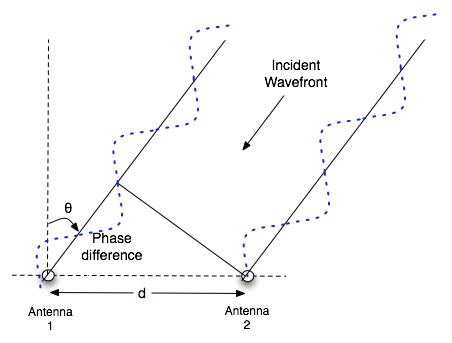 | ||
Phase-comparison monopulse (also called phase-interferometry) describes a technique that can be used in radar and direction finding applications to accurately estimate the direction of arrival of a signal from the phase difference of the signal measured on two (or more) separated antennas.
Mathematics
Assume two antenna separated by a distance d, with a wavefront incident at an angle θ, then the extra path the signal must travel between Antenna 1 and Antenna 2 (see figure) results in a phase difference, ΔΦ, between the two antennas. This can be used to calculate the direction of arrival using:
where λ is the signal's wavelength.
For unambiguous results, the antennas should be spaced half a wavelength apart, or less. However, this can result in significant mutual coupling between elements, which means that each antenna's phase measurement will be corrupted by the other's. The approach assumes that the phase centres of the antennas are exactly known. With more complex antenna structures (such as the log-periodic antenna) the effects of mutual coupling can make the phase centre locations unknown. In this case, calibration or electromagnetic modeling may be required.
The ability to accurately measure a signal's phase depends on the signal-to-noise ratio (SNR), and hence the accuracy of this technique is dependent on the SNR.
